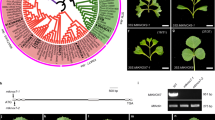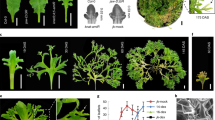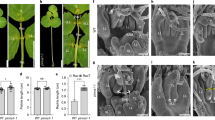Abstract
A key question in biology is how differences in gene function or regulation produce new morphologies during evolution. Here we investigate the genetic basis for differences in leaf form between two closely related plant species, Arabidopsis thaliana and Cardamine hirsuta. We report that in C. hirsuta, class I KNOTTED1-like homeobox (KNOX) proteins are required in the leaf to delay cellular differentiation and produce a dissected leaf form, in contrast to A. thaliana, in which KNOX exclusion from leaves results in a simple leaf form. These differences in KNOX expression arise through changes in the activity of upstream gene regulatory sequences. The function of ASYMMETRIC LEAVES1/ROUGHSHEATH2/PHANTASTICA (ARP) proteins to repress KNOX expression is conserved between the two species, but in C. hirsuta the ARP-KNOX regulatory module controls new developmental processes in the leaf. Thus, evolutionary tinkering with KNOX regulation, constrained by ARP function, may have produced diverse leaf forms by modulating growth and differentiation patterns in developing leaf primordia.
This is a preview of subscription content, access via your institution
Access options
Subscribe to this journal
Receive 12 print issues and online access
$209.00 per year
only $17.42 per issue
Buy this article
- Purchase on Springer Link
- Instant access to full article PDF
Prices may be subject to local taxes which are calculated during checkout




Similar content being viewed by others
References
Carroll, S.B. Evolution at two levels: on genes and form. PLoS Biol. 3, e245 (2005).
Byrne, M.E. et al. Asymmetric leaves1 mediates leaf patterning and stem cell function in Arabidopsis. Nature 408, 967–971 (2000).
Ori, N., Eshed, Y., Chuck, G., Bowman, J.L. & Hake, S. Mechanisms that control knox gene expression in the Arabidopsis shoot. Development 127, 5523–5532 (2000).
Schneeberger, R., Tsiantis, M., Freeling, M. & Langdale, J.A. The rough sheath2 gene negatively regulates homeobox gene expression during maize leaf development. Development 125, 2857–2865 (1998).
Tsiantis, M., Schneeberger, R., Golz, J.F., Freeling, M. & Langdale, J.A. The maize rough sheath2 gene and leaf development programs in monocot and dicot plants. Science 284, 154–156 (1999).
Timmermans, M.C., Hudson, A., Becraft, P.W. & Nelson, T. ROUGH SHEATH2: a Myb protein that represses knox homeobox genes in maize lateral organ primordia. Science 284, 151–153 (1999).
Bharathan, G. et al. Homologies in leaf form inferred from KNOXI gene expression during development. Science 296, 1858–1860 (2002).
Kim, M., McCormick, S., Timmermans, M. & Sinha, N. The expression domain of PHANTASTICA determines leaflet placement in compound leaves. Nature 424, 438–443 (2003).
Koch, M., Haubold, B. & Mitchell-Olds, T. Molecular systematics of the Brassicaceae: evidence from coding plastidic matK and nuclear Chs sequences. Am. J. Bot. 88, 534–544 (2001).
Long, J.A., Moan, E.I., Medford, J.I. & Barton, M.K. A member of the KNOTTED class of homeodomain proteins encoded by the SHOOTMERISTEMLESS gene of Arabidopsis. Nature 379, 66–69 (1996).
Dinneny, J.R., Yadegari, R., Fischer, R.L., Yanofsky, M.F. & Weigel, D. The role of JAGGED in shaping lateral organs. Development 131, 1101–1110 (2004).
Kim, J.Y., Yuan, Z. & Jackson, D. Developmental regulation and significance of KNOX protein trafficking in Arabidopsis. Development 130, 4351–4362 (2003).
Hay, A., Jackson, D., Ori, N. & Hake, S. Analysis of the dompetence to respond to KNOTTED1 activity in Arabidopsis leaves using a steroid induction system. Plant Physiol. 131, 1671–1680 (2003).
Hareven, D., Gutfinger, T., Parnis, A., Eshed, Y. & Lifschitz, E. The making of a compound leaf: Genetic manipulation of leaf architecture in tomato. Cell 84, 735–744 (1996).
Chen, J-J., Janssen, B-J., Williams, A. & Sinha, N. A gene fusion at a homeobox locus: Alterations in leaf shape and implications for morphological evolution. Plant Cell 9, 1289–1304 (1997).
Waites, R., Selvadurai, H.R., Oliver, I.R. & Hudson, A. The PHANTASTICA gene encodes a MYB transcription factor involved in growth and dorsoventrality of lateral organs in Antirrhinum. Cell 93, 779–789 (1998).
Xu, L. et al. Novel as1 and as2 defects in leaf adaxial-abaxial polarity reveal the requirement for ASYMMETRIC LEAVES1 and 2 and ERECTA functions in specifying leaf adaxial identity. Development 130, 4097–4107 (2003).
Wesley, S.V. et al. Construct design for efficient, effective and high-throughput gene silencing in plants. Plant J. 27, 581–590 (2001).
Gleave, A.P. A versatile binary vector system with a T-DNA organisational structure conducive to efficient integration of cloned DNA into the plant genome. Plant Mol. Biol. 20, 1203–1207 (1992).
Theodoris, G., Inada, N. & Freeling, M. Conservation and molecular dissection of ROUGH SHEATH2 and ASYMMETRIC LEAVES1 function in leaf development. Proc. Natl. Acad. Sci. USA 100, 6837–6842 (2003).
Chuck, G., Lincoln, C. & Hake, S. Knat1 induces lobed leaves with ectopic meristems when overexpressed in Arabidopsis. Plant Cell 8, 1277–1289 (1996).
Craft, J. et al. New pOp/LhG4 vectors for stringent glucocorticoid-dependent transgene expression in Arabidopsis. Plant J. 41, 899–918 (2005).
Lenhard, M., Jurgens, G. & Laux, T. The WUSCHEL and SHOOTMERISTEMLESS genes fulfil complementary roles in Arabidopsis shoot meristem regulation. Development 129, 3195–3206 (2002).
Smith, L.G., Greene, B., Veit, B. & Hake, S. A dominant mutation in the maize homeobox gene, Knotted-1, causes its ectopic expression in leaf cells with altered fates. Development 116, 21–30 (1992).
Scanlon, M.J., Schneeberger, R.G. & Freeling, M. The maize mutant narrow sheath fails to establish leaf margin identity in a meristematic domain. Development 122, 1683–1691 (1996).
Bowman, J.L., Smyth, D.R. & Meyerowitz, E.M. Genetic interactions among floral homeotic genes of Arabidopsis. Development 112, 1–20 (1991).
Acknowledgements
We thank S. Hake for 35S::BP and 35S::KN1-GR plasmids and helpful discussions; M. Scanlon for anti-KNOX antibody, J. Long for STM plasmid and advice on in situ hybridization; I. Furner for mutagenesis, T. Rich, S. Hiscock and D. Bailey for help with C. hirsuta identification; Y. Eshed and J. Bowman for cloning vectors, FIL::LhG4 and PHV::LhG4 lines; M. Lenhard for ANT::LhG4; J. Craft for VTOp::BP and VTOP::STM lines; I. Moore for discussions on the LhG4 transcription activation system and S. Langer and M. Anezaki for technical assistance. We also thank J. Langdale for comments on the manuscript, A. Hudson for helpful discussions, J. Baker for photography and Genome and Agricultural Biotechnology for support of library construction. This work was funded by a Biotechnology and Biological Sciences Research Council grant and Oxford University Pump Priming grant to M.T. A.H is the recipient of a University of Oxford Glasstone Research Fellowship and a Balliol College Junior Research Fellowship. We also acknowledge the support of the Gatsby Charitable foundation and the Royal Society.
Author information
Authors and Affiliations
Corresponding author
Ethics declarations
Competing interests
A patent application for the use of this system for commercial purposes has been filed by ISIS Innovation, the technology transfer company of the University of Oxford.
Supplementary information
Supplementary Fig. 1
Sequence comparisons of 5′ upstream regions of STM and BP from Arabidopsis and C. hirsuta. (PDF 187 kb)
Supplementary Fig. 2
Leaflet formation in response to ectopic KNOX activity in Arabidopsis. (PDF 1311 kb)
Supplementary Fig. 3
Predicted C. hirsuta AS1 protein sequence. (PDF 118 kb)
Supplementary Fig. 4
Increased KNOX protein accumulation in C. hirsuta AS1 RNAi leaves. (PDF 103 kb)
Supplementary Fig. 5
Loss of adaxial cell differentiation in chas1-1 leaves. (PDF 334 kb)
Supplementary Fig. 6
Analysis of transcript levels in RNAi lines. (PDF 429 kb)
Supplementary Table 1
Primer sequences. (PDF 51 kb)
Rights and permissions
About this article
Cite this article
Hay, A., Tsiantis, M. The genetic basis for differences in leaf form between Arabidopsis thaliana and its wild relative Cardamine hirsuta. Nat Genet 38, 942–947 (2006). https://doi.org/10.1038/ng1835
Received:
Accepted:
Published:
Issue Date:
DOI: https://doi.org/10.1038/ng1835
This article is cited by
-
Rewiring of a KNOXI regulatory network mediated by UFO underlies the compound leaf development in Medicago truncatula
Nature Communications (2024)
-
Control of compound leaf patterning by MULTI-PINNATE LEAF1 (MPL1) in chickpea
Nature Communications (2023)
-
Identification and expression analysis of the KNOX genes during organogenesis and stress responseness in Camellia sinensis (L.) O. Kuntze
Molecular Genetics and Genomics (2023)
-
The developmental dynamics in cool season legumes with focus on chickpea
Plant Molecular Biology (2023)
-
The diverse roles of cytokinins in regulating leaf development
Horticulture Research (2021)



